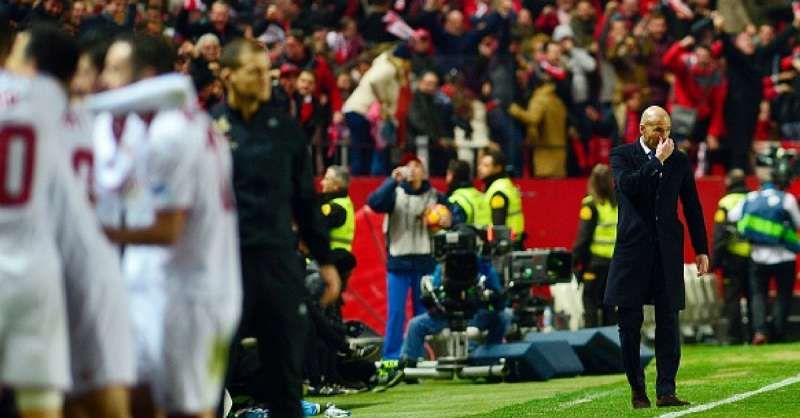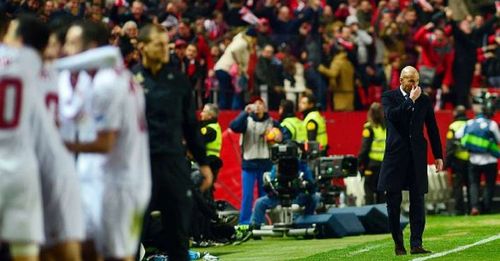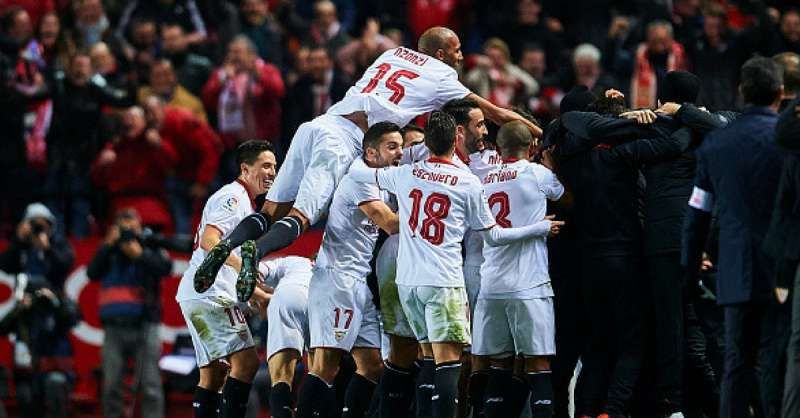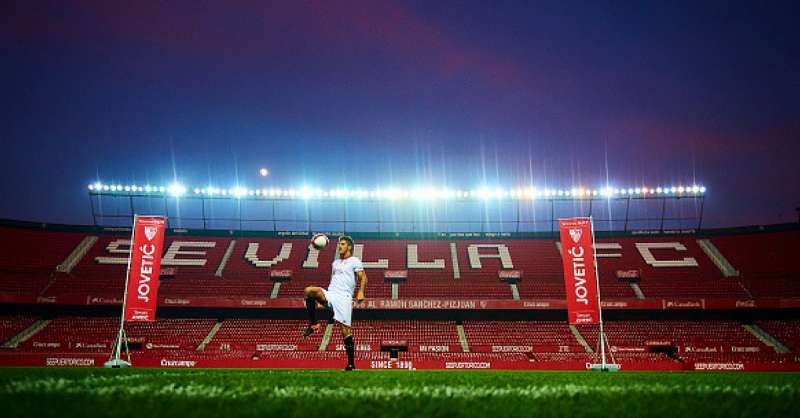
La Liga 2016/17: Is this the summer of the dancing bullfighters of Seville?
"Madame, all stories, if continued far enough, end in death, and he is no true-story teller who would keep that from you"
It was a great story that Zinedine Zidane was in the middle of scripting at Real Madrid. 40 games spread across nine months, played against 30 teams in five competitions, they had remained unbeaten.
Bedecked in purple, Zidane's Madrid had walked out three days ago to a vociferous reception at the Estadio Ramon Sanchez Pizjuan, and had almost lost their first match in nine months. They were, in fact, less than a minute away... till Karim Benzema decided that he needed to remind everyone what that middle B in BBC stood for. They drew 3-3.
When they met late on Sunday, Madrid led 1-0 for over 85 minutes... for all the world, it felt like that unbelievable unbeaten run of theirs would never end.
But football is a great story teller.
And she apparently listens to Ernest Hemingway.
El Himno del Seville
Cuentan las lenguas antiguas
que un 14 de octubre nació una ilusión
su madre fue Sevilla, y le prestó su nombre
y paradefenderlo le dio a una afición… (this just a little bit of it)
For those of us who "no hablo espanol" , this is what the anthem roughly translates to...
The story goes, that on 14 October* a dream was born,
Her mother was Seville, she gave her her name and a support to defend her.
A great example of Seville, the red and white family of the Sánchez Pizjuán,
A heart that beats shouting Sevilla, lifting the team to victory.
And that's why I've come to watch you today,
I'll be a Sevillista until I die,
The Giralda** looks proudly on Sevilla in the Sánchez Pizjuán,
And Sevilla, Sevilla, Sevilla, here we are with you Sevilla,
Sharing the glory in you badge, the footballing pride of our city.
They say you never give up, and that your football art has no rival,
My team's been fighting for 100 years, flying the flag of the city.
A great example of Seville, the red and white family of the Sánchez Pizjuán,
A heart that beats shouting Sevilla, lifting the team to victory.
*Sevilla FC was formed on 14th October 1905
**the bell tower of Seville's great cathedral
The people of Seville love their bullfighting. A peek at the grandeur of the Plaza de toros de la Real Maestranza – seated in the heart of the city – would suffice to reaffirm that. And they also love their football.
The Ramon Sanchez Pizjuan is built in the best traditions of Spanish football stadia, with stands climbing almost vertically up – giving the footballers on the pitch the feeling that the fans are almost on top of their heads. And when the 42,000 Sevillistas that cram the majestic stadium start with their rendition of the hymn of Seville, it can make for an overpowering spectacle.
For the longest time though, their footballing heroes have struggled to match the sheer success of their beloved toreros (bullfighters). Their team has always had the right ingredients in place – the Banderilleros (flagmen), the Mozo de espadas (assistants), the Novilleros (junior/apprentice bullfighter), the Picadores (lancers on horseback) – but not the kind of Matadore (literally the bull-killer) so necessary to take the spectacle to the next level... to match the shows being put up in the great northern cities of Madrid and Barcelona.
In the 93rd minute against Madrid, though, one player seemed to step out of the shadows. Having come to the southern tip of the Iberian peninsula all the way from Montenegro – via Florence and Milan – Stevan Jovetic had already scored for Los Rojiblancos against Madrid in that frenetic 3-3 draw. This time his goal – with virtually the last kick of the match - would seal a famous win.
That's some way to kill the bull... if he had done this at the Plaza de la Maestranza, he would have been walking around with two ears and the tail.
The coach Jorge Sampaoli had celebrated the hardest – as is his way – jumping up and down whilst running around, overcome by a combination of joy and disbelief. It was his moment... it was Seville's. It announced to the rest of Spain that they'd finally arrived at the Big Stage.
The method in Sampaoli's madness
"I believe that the only way to succeed is by uniting players with a love of playing," Sampaoli once said. "You try to inspire in them a love of the shirt derived of enjoyment, not obligation. When you succeed in this individualistic society, it is by committing to something intangible, with humility. That allows everybody to come together; the social or cultural background of the people involved doesn't matter."
High-brow philosophy, and a little mad, perhaps, but you can sense the kernel of truth within – enjoy what you are doing, and you will end up doing it well.
A fervent disciple of Marcelo Bielsa, Sampaoli has instilled in his perennial underdogs the idea that there is no way to play football but to go all out – high intensity pressing off the ball, and overpowering opponents with direct, vertical attacks along the flanks when on it. He has sought to unite the players, and boy, have they responded.
They've lost only once at the Pizjuan – and that too against an inspired Lionel Messi (like Sampaoli said, Leo lets you stop him on occasion.. but sometimes he doesn't) – and they've never played better football. The most points they've ever garnered at the halfway stage of a La Liga season is 38... this season, they already have 39 – with a game to go.
They are in the knock-stages of the UEFA Champions League after what feels like an eternity.
They've not finished as well as they should have, nor created as much as they could have – and yet have scored 38 goals. No Sevilla side in their 112 years of existence has scored more during the first half of a first division season. They've never before been in second place in La Liga at this stage.
They've married their city's two great loves – bullfighting and Flamenco – and have composed spectacle after stunning spectacle at the Pizjuan, that can genuinely be considered as being composed by some of the most entertaining football in Europe... and some of the most effective.
Pablo Sarabia and Vitolo have torn up and down the flanks with frightening pace, Ben Yedder and have Luciano Vietto been quietly efficient, Samir Nasri has been a revelation – making things tick in that inimitable way of his. Steven N'Zonzi, the man his manager calls an octopus, has been an omnipotent, omnipresent, phenomenon. And now they have a player capable of becoming a genuine world-beater in Stevan Jovetic – just what they, and to be honest, La Liga, needed.
Sampaoli has been magnificent himself, sticking true to Bielsisima and playing a 3-3-1-3, but changing it up when the occasion, and the opposition, have demanded it. He has played a three-man backline at times, a four-man defence at others. He has played with a two-man strike force, but at times he has attacked in a reverse Christmas tree formation that harks back to the glory days of 60's Santos... 2-4-4 is not something you see on a football pitch too often these days.
He has adapted his team to the opposition, but without ever losing sight of the fact that he doesn't need to change his style of play... or his philosophy.
"We will not allow ourselves to be modified by our opponents. We have to want it more than opponents, to surpass them in spirit. We will go mano a mano against anyone. Our idea is to surprise opponents who are used to having opponents play against them in a certain way."
He said that while coaching Chile, but Sevilla have imbibed almost every word of that. Be it Eibar or Barcelona, Las Palmas or Real Madrid, Sevilla have played the way Sevilla always plays.
You see, most importantly, Sevilla have what Sampaoli's teams have always had, what Seville's greatest toreros have always had... cojones. And it is this that might just let the proud Andalusians dethrone the mighty Castilians and Catalans off the Spanish throne, a pedestal that ‘those two’ feel is their birthright.
This might just be the summer of Seville's dancing bullfighters.



